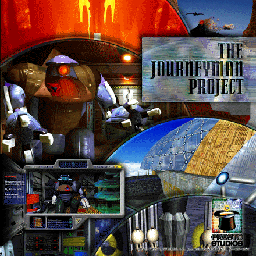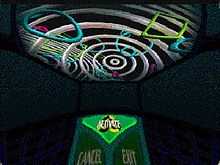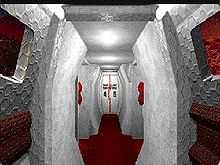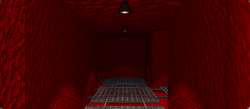The Journeyman Project
| The Journeyman Project | |
|---|---|
 | |
| Developer(s) | Presto Studios |
| Publisher(s) | Presto Studios Sanctuary Woods Bandai |
| Designer(s) | David Flanagan |
| Engine | Macromedia Director 2.0 |
| Platform(s) | Mac OS, Windows |
| Release date(s) | (The Journeyman Project) 1993 (TJP Turbo) 1994 |
| Genre(s) | Adventure game |
| Mode(s) | Single player |
| Distribution | CD-ROM (1) |
The Journeyman Project is a time travel adventure computer game developed by Presto Studios.
Gameplay
The game features a first-person perspective. The protagonist sees a display, a rectangle shaped visor (acting as a monocle for Agent 5). This user interface helps to reduce the movie size and maintain relatively high frame rates. Controls work as four interface buttons located below the screen. They move Agent 5 forward and backward, and rotate Agent 5 left and right.
The Journeyman Project was billed as interactive movie adventure game, where the player is presented with several clues and puzzles that must be solved in order to move on or finish the level. Items that the player finds can be helpful or harmful as he attempts to explore his surroundings. The most important of these items are the seven bio-chips, which enhance the player-character's abilities in various ways. The game's user interface stores the bio-chips in a special "bio-chip panel", which serves as a "quick-menu" for activating and deactivating the various chips.
Story

The game takes place in the distant future, after the Earth has been united to a peaceful global community. A scientist has discovered the technology of time travel but because of its dangerous nature, the prototype machine, 'Pegasus', has been placed under government supervision and further attempts at traveling through time or developing time travel technology are forbidden by law.[1]
The game begins as humanity welcomes the first alien delegation to visit the planet, and prepares to answer positively to an invitation to join the interplanetary "Symbiotry of Peaceful Beings". During the induction ceremony, the government-operated Temporal Security Annex, which was established to oversee the lock-down of the Pegasus machine, detects three temporal disturbances that have altered the timeline; the Annex mobilizes Agent 5 to correct the disruptions, which have altered the timeline so that Earth's meeting with the Symbiotry representatives is one of mutual distrust and aggression rather than cooperation.

Upon arriving at the Annex, Agent 5 discovers that the anachronisms are related to Earth's first contact with the Symbiotry; ten years prior, the aliens had extended their offer, and planned to return in one decade to receive Earth's answer. An unknown party has altered the timeline to prevent contact with the Symbiotry, either through preventing them from reaching Earth or changing humanity's reaction to the aliens' arrival.
The disruptions occurred during three key events in Earth's recent past:
- The conference of 2112 which led to peace and prosperity through the unification of Earth over opposing voices. The robot Poseidon sends a nuclear missile to detonate above Ghorbistan so that fear prevents the countries from proceeding with the acceptance of the treaty.
- The first acknowledged contact with an alien ship in 2185 above Mars. The robot Ares is sent to sabotage the Morimoto Mars Colony so that humanity connects the aliens with the colony's destruction, and grow skeptical of their intentions.
- The Pro-alien rally of 2310 where the speech of Dr. Enrique Castillo persuaded the opposing scientists to accept joining the Symbiotry. Robot Mercury was sent to assassinate Castillo so that the opposition prevailed.
After exploring all three time periods, and collecting evidence from each, Agent 5 discovers that the person responsible for the disruptions is Dr. Elliot Sinclair, the inventor of the Pegasus time machine. He fears that the aliens are a malevolent force rather than a peaceful race, and is doing everything in his power to make Earth an unsuitable candidate for joining the aliens.
In all three scenarios, the player has two ways to neutralize the robots—one "peaceful" and one "aggressive"—which will affect the player's overall score. The player also gains bio-chips from each robot when he completes each scenario successfully.

After correcting the anachronisms created by Dr. Sinclair, Agent 5 learns that the doctor decided to take matters into his own hands and assassinate the alien delegate sent to receive Earth's answer. Agent 5 finds Dr. Sinclair hiding on top of an apartment building and holding a rifle, ready to fire on the delegate as soon as he arrives. After a brief scuffle, Agent 5 arrests Dr. Sinclair, allowing history to take its proper course.
Development

The Journeyman Project was released in 1992 after 2 years of development. The game impressed the gaming press with its use of high quality rendered environments, stylistic artwork and digital audio.
Due to performance difficulties, the game was re-released in 1994 as Journeyman Project Turbo!, with an updated executable that drastically decreased loading times and improved animation quality.
Two sequels (Buried in Time and Legacy of Time) were released in subsequent years, and a fourth game was in the design stage before Presto Studios closed in November 2002; it was eventually shelved in favor of work on Myst III: Exile.
A redesign of the game, with the subtitle of Pegasus Prime, was released for the Power Macintosh; it featured updated graphics, enhanced and updated sounds and puzzles, and improved video technology. Plans to release it on multiple platforms were cancelled. In April 2014 the game was released on PC for the first time on Good Old Games.
Reception
Computer Gaming World called The Journeyman Project "visuall stunning" and its world "believably fantastic". The magazine stated that the game was "as tough as they come" and recommended built-in hints, but concluded that "It is all the more rewarding after puzzling past each conundrum".[1] In 1993, Dragon gave the game 4 out of 5 stars.[2]
Releases and bug fixes
The game suffered from performance problems and slow animations due to its early reliance on Macromedia Director. These problems were mostly overcome with the version 2.0 release and retitled as The Journeyman Project Turbo! under the publisher Sanctuary Woods in 1994.
- The Journeyman Project v1.0 (1992) – original self-published release for Macintosh
- The Journeyman Project v1.1 (1992) – bug fixes
- The Journeyman Project v1.2 (1993) – performance upgrade, fastest Mac version until TJP Turbo
- The Journeyman Project MPC v1.0 (1993) – first release for Windows 3.1
- The Journeyman Project Turbo (1994) – unified release for Mac and PC with major speed improvements
- The Journeyman Project: Pegasus Prime (1997) – a complete remake of the original
Notes
- ↑ 1.0 1.1 Reveaux, Tony (1993-07). "Journey Back to the Future in Presto Studios' The Journeyman Project". Computer Gaming World. p. 76. Retrieved 12 July 2014. Check date values in:
|date=(help) - ↑ Lesser, Hartley; Lesser, Patricia & Lesser, Kirk (August 1993). "The Role of Computers". Dragon (196): 59–63.
External links
| Wikiquote has quotations related to: The Journeyman Project |
- The Journeyman Project at MobyGames
- The Journeyman Project at the Internet Movie Database
- The Journeyman Project: Turbo! at MobyGames
- Archived homepage for The Journeyman Project Turbo
- Interview with Tommy Yune, Adventure Classic Gaming (2007)
- Legacy of The Journeyman Project, Adventure Classic Gaming (1999)